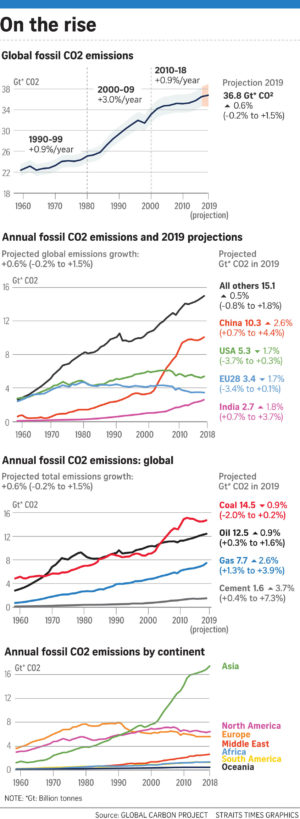Global CO2 emissions to hit new record this year–report
SINGAPORE — Emissions of carbon dioxide (CO2), the main greenhouse gas blamed for heating up the planet, are forecast to rise again this year to reach another record high, a report published Thursday shows.
But emissions growth will be slower partly because of the weaker global economy and a fall in global coal use, says the report, known as the Global Carbon Budget.
The authors forecast CO2 emissions will grow 0.6 percent in 2019, compared with 2.1 percent the previous year.
But the forecast is not yet a sign that the global economy is shifting quickly away from fossil fuel use, a move that is needed to reduce the risks of more extreme weather events and rising sea levels.

CO2 emissions are set to reach 36.8 billion tonnes this year, up more than 60 percent since 1990.
The drop in coal use was largely offset by growth in oil and natural gas consumption, underscoring that the world is still far off course in making the deep carbon cuts needed. Coal use fell a surprising 10.5 percent in the United States and 10 percent in the European Union, the world’s No. 2 and 3 carbon emitters, the report says.
Weaker coal emissions growth in China (0.8 percent) and India (2 percent) also limited emissions growth this year.
“The decline in coal use is to a large extent being replaced by natural gas, further locking us into fossil fuel infrastructure, and the boom in liquefied natural gas (LNG) is providing a new global commodity for expansion of natural gas,” said Dr Pep Canadell, executive director of the Global Carbon Project, an international research group that publishes the Global Carbon Budget.
The budget was published in several journals, including Nature Climate Change, on the sidelines of major UN climate talks in Madrid.
The assessment is a closely watched planetary health check and Dr Canadell told The Straits Times that the slowing growth in emissions is more a reflection of weaker economic growth and economic uncertainties.
“Given the world’s energy system is still dominated by fossil fuels by more than 80 per cent, economic growth is always in lock step with growth in CO2 emissions.”
Coal use is closely watched because it remains the single largest source of CO2 emissions from burning fossil fuels – coal use accounted for 42 percent of global fossil fuel CO2 emissions in the past decade.
What China does also matters. China consumes half the world’s coal and it is also by far the world’s top greenhouse gas polluter.
A significant long-term shift away from coal in China is needed to lower global CO2 emissions.
China has been investing heavily in renewable energy to help meet its growing energy demands but the nation remains heavily reliant on coal and, increasingly, on gas.
Globally, strong investment in solar, wind and electric vehicles has, at best, only slowed the growth in global fossil fuel emissions, the report says.
It adds that wildfires in Brazil, Indonesia, California and elsewhere led to a surge in CO2 pollution.
Preliminary estimates of emissions from fires, deforestation and other land-use changes for 2019 reached 6 billion tonnes of CO2, against about 5.2 billion tonnes last year. That is more than the annual CO2 emissions from the US.
Asked if there was anything positive in this year’s carbon budget report, Dr Canadell pointed to the sharp drop in coal emissions in the US and the EU. “This is about double the speed at which coal emissions have fallen over the past five years. It shows how fast energy systems can change when policies and/or economics, and hopefully both, work to support the transition to a low-carbon economy.”
He said that over the past 10 years, the US has had 500 coal-powered plants closed or put on notice for closure, while Britain’s electricity production has fallen from 40 per cent coal-fired power generation to 5 per cent in seven years. “These are all achievements to celebrate and show change is possible.”